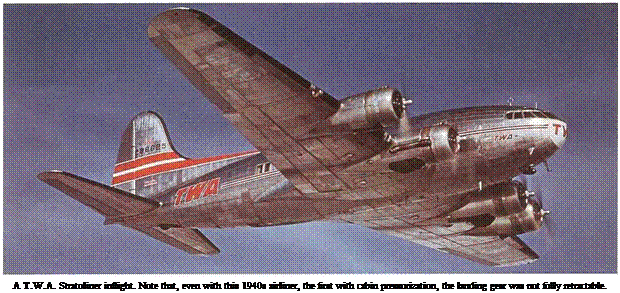Post-War Reconstruction


Return of the Stratoliners
On 28 April 1944, the last Boeing 307 Stratoliner was returned to T. W.A. when Air Transport Command had received sufficient Douglas C-54s, which could carry more load and for a longer distance. During their military use, the 307s had been flown intensively and were badly in need of renovation. This was done at Albuquerque; and between 14 March and 24 April 1945, the fleet was re-certified for commercial use, and designated SA-307B-ls, after thorough modification and inspection. Scheduled services were resumed on 1 April and, until 15 February 1946, they were the only four-engined landplanes in service by U. S. airlines.
Early Coach Class
The fate of all airliners is to be relegated from the front line when a new generation makes its appearance. In the case of T. W.A.’s Boeing 307s, they stayed in service and added one more claim for recognition in their eventful history. On 31 May 1949, the Stratoliner Coach Service began between New York and Chicago, via Pittsburgh. The fare was $29.40, a reduction of 30% from the regular fare of $44.10. No meals were served and reservations had to be paid for in advance. But it was one of the best of the such promotional fares, first launched by Capital Airlines in 1948, in response to the growing popularity of bargain offers by the non-scheduled charter airlines.
Old 307s Never Die
As the Constellations took over all the overseas routes from the DC-4s; and the DC-4s supplemented the DC-3s on the domestic network, even the veteran ‘Gooney Birds’ were retired. Their departure was speeded by the pending arrival of the Martin 202 (see page 61), one of the airhners sometimes described as the “DC-3 Replacement,” about the same size as the Stratoliner, but more powerful, faster, and, with two fewer engines, more economical. The Boeing veterans were retired from May 1950, the last one on 1 July 1950. They were sold to the French airline, Aigle Azur, which operated them in various roles in Europe, and when the French met with the growing nationalism in their Indo-China colony, they flew troops to and from Saigon. They performed a variety of missions there, and during the Vietnam War, were used for United Nations liaison work, flying between Saigon and Hanoi, under the title (if not the colors) of CIC (see caption to photograph.) All the T. W.A. 307s came to ignominious ends, but one of the Pan American planes is preserved (see page 45).
Some of the Stratoliners had an interesting fa te. After service with the French airline Aigle Azur, they were dispersed after the French colonial regime in Indo-China came to an end. Early in 1964, two of them passed to the Compagnie Internationale de Transports Civils Aeriens (CIC). They provided a service between Saigon and Hanoi, on behalf of the International Control Commission, (photo courtesy Roger Bentley)










